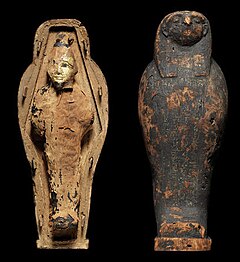Our website is made possible by displaying online advertisements to our visitors.
Please consider supporting us by disabling your ad blocker.
Mysteries of Osiris
| Mystères d'Osiris | |
|---|---|
 | |
| Type | Religious festivities |
| Significance | Commemoration of the martyrdom of Osiris |
| Observances | Procession of sacred boats, tributes to the dead |
| Begins | 12 Khoiak |
| Ends | 30 Khoiak |
| Started by | Ancient Egyptians |
| Related to | Nilotic Calendar |
The Mysteries of Osiris, also known as Osirism,[1] were religious festivities celebrated in ancient Egypt to commemorate the murder and regeneration of Osiris. The course of the ceremonies is attested by various written sources, but the most important document is the Ritual of the Mysteries of Osiris in the Month of Khoiak, a compilation of Middle Kingdom texts engraved during the Ptolemaic period in an upper chapel of the Temple of Dendera. In Egyptian religion, the sacred and the secret are intimately linked. As a result, ritual practices were beyond the reach of the uninitiated, as they were reserved for the priests, the only ones authorised to enter the divine sanctuaries. The most unfathomable theological mystery, the most solemnly precautionary, is the remains of Osiris. According to the Osirian myth, this mummy is kept deep in the Duat, the subterranean world of the dead. Every night, during his nocturnal journey, Ra, the solar god, came there to regenerate by temporarily uniting with Osiris in the form of a single soul.
After the collapse of the Old Kingdom, the city of Abydos became the centre of Osirian belief. Every year, a series of public processions and secret rituals were held there, mimicking the passion of Osiris and organised according to the royal Memphite funeral rituals. During the first millennium BC, the practices of Abydos spread to the country's main cities (Thebes, Memphis, Saïs, Coptos, Dendera, etc.). Under the Lagids, every city demanded to possess a shred of the holy body or, failing that, the lymph that had drained from it. The Mysteries were based on the legend of the removal of Osiris' corpse by Set and the scattering of his body parts throughout Egypt. Found one by one by Isis, the disjointed limbs are reassembled into a mummy endowed with a powerful life force.
The regeneration of the Osirian remains by Isis-Chentayt, the "grieving widow", takes place every year during the month of Khoiak, the fourth of the Nilotic calendar (straddling the months of October and November). In the temples, the officiants set about making small mummiform figurines, called "vegetative Osiris", to be piously preserved for a whole year. These substitutes for the Osirian body were then buried in specially dedicated necropolises, the Osireions or "Tombs of Osiris". The Mysteries are observed when the Nile begins to recede, a few weeks before the fields can be sown again by the farmers. Each of the ingredients used to make the figurines (barley, earth, water, dates, minerals, herbs) is highly symbolic, relating to the main cosmic cycles (solar revolution, lunar phases, Nile flood, germination). The purpose of mixing and moulding them into the body of Osiris was to invoke the divine forces that ensured the renewal of life, the rebirth of vegetation and the resurrection of the dead.
- ^ "Definition of OSIRISM". www.merriam-webster.com. Retrieved 2024-06-03.
Previous Page Next Page


